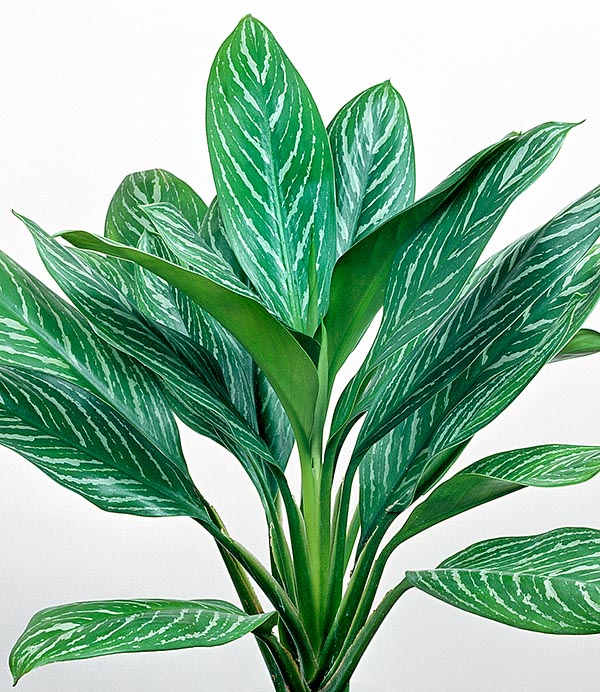Family : Araceae

Text © Pietro Puccio

English translation by Mario Beltramini

Native to the humid forests of peninsular Malaysia and Lingga Archipelago, Aglaonema nitidum f. curtisii is also an easy indoor plant that has originated several very appreciated hybrids © Giuseppe Mazza
The Aglaonema nitidum f. curtisii (N.E.Br.) Nicolson (1968) is native to the humid forests of peninsular Malaysia and Lingga Archipelago.
The name of the genus is the combination of the Greek words “aglaos” = bright, and “néma” = thread, with possible reference to the bright stamens of the flowers; the name of the species is the Latin word “nitidum” = bright, whilst the form assumes the name from its collector, Charles Curtis (1853-1928).
Evergreen, herbaceous perennial plant, it forms a stem usually erect, tall up to 1-1,2 m and with a diameter varying from 1 to 3 cm, with internodes of about 1-2 cm; leaves on 10-25 cm long petioles, from elliptic to oblong, sharp at the apex, 20-45 cm long and 10-15 cm broad, of an intense glossy green colour with silvery-grey variegations along the lateral venations or irregularly distributed.
Inflorescences on 10-18 cm peduncles, formed by an initially pale green spathe, which changes later on to white, 3-8 cm long, and a 4-7 cm long spadix, with the female flowers occupying the lower part for about 1 cm, the remainder being occupied by the male ones. The fruits are ovoid berries, white when ripe.
It reproduces by seed, division, eye or stem cutting.
The plant can be cultivated in open spaces in the tropical and humid subtropical climate zones in shaded position, on draining organic substrata, slightly acid or neutral soils, elsewhere, it is cultivated in pot, and as such is appreciated for indoor decoration thanks to its highly ornamental foliage and the reduced height, as usually it does not overcome the meter. Although it bears staying in the shade, a luminous position, but far away from direct sun, will exalt its variegation.
The substratum must be organic, with addition of sand or agri-perlite, porous and well drained, in order to avoid root rottenness. The temperature must be kept over 14-16°C, best around 20-22°C, without sudden variations. During the vegetative period, watering must be regular and the substratum is to be kept humid, but without stagnations, in winter, watering must be reduced, especially if the temperatures get close to the lower limit, but without drying up completely the substratum.
This particular form has originated several hybrids, much appreciated for indoor decoration
Synonyms: Aglaonema oblongifolium var. curtisii N.E.Br. (1897); Aglaonema nitidum f. cinereum Jervis (1980).
